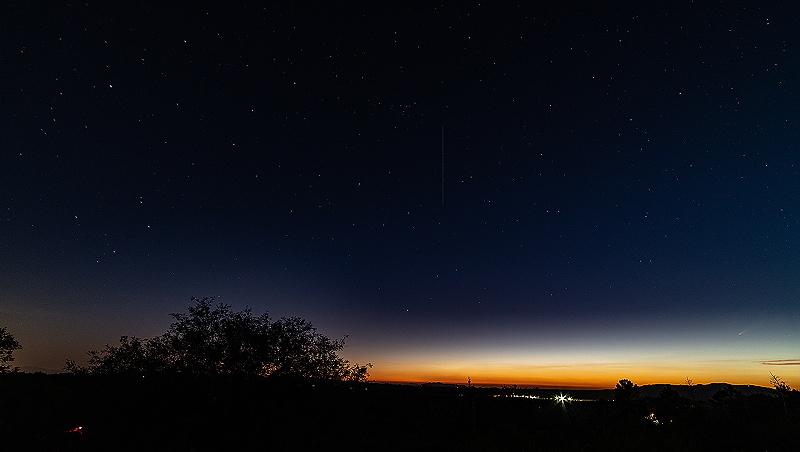Comet NEOWISE, New Eyepieces More Tests
Posted: 15 July 2020
The sky dawned mostly clear on Tuesday, 14 July 2020, with a forecast for a clear night that would allow my second sighting of Comet C/2020 F3 NEOWISE. Unfortunately, clouds returned and the forecast changed to mostly cloudy. Then things changed again and it cleared up after sunset.
2025 MST: observed the comet using 7x50 binoculars. As a test I took this wide angle photo of the western sky. It shows from the southwest to the northwest. The comet is just above the horizon in the lower righthand corner. The bottom stars of the bowl of the Big Dipper (upper right) point towards the comet. Click or tap on the image for a larger view.
2030 MST: f/8, 30 seconds, ISO 400, FL 14mm UWA

Click or tap on image for larger version
Here are some additional photographs of Comet C/2020 F3 NEOWISE.
2038 MST: f/5.6, 2 seconds, ISO 4000, FL 70mm

Click or tap on image for larger version
2040 MST: f/11, 2 seconds, ISO 6400, FL 185mm

2045 MST: f/5.6, 2 seconds, ISO 12800, FL 300mm (cropped)

2047 MST: f/5.6, 1 second, ISO 12800, FL 185mm

By 2045 MST the comet with its long tail was visible to the naked eye.
The comet will continue to be higher in the northwestern sky after sunset each night.
As the sky was still mostly clear after observing the comet I opened the observatory.
|
Open: Tuesday, 14 July 2020, 2104 MST Temperature: 94°F |
Session: 1500 Conditions: Mostly clear |
Equipment:
12" f/8 LX600 w/StarLock
2" 24mm UWA eyepiece
2" 17mm 92° eyepiece
2" 12mm 92° eyepiece
2" 9mm 120° eyepiece
Camera:
iPhone 11 Pro Max
2118 MST: LX600 ON, StarLock OFF, High Precision OFF.
I did some more tests of the 92° AFOV and 120° AFOV eyepieces from Explore Scientific for an upcoming review in Astronomny Technology Today magazine. I observed some Deep Sky Objects and the planets Jupiter and Saturn during the tests.
2211 MST: tests completed.
Viewed Saturn, 102X. Seeing was not very good due to some clouds.
2115 MST: LX600 OFF.
2125 MST: took a Sky Quality Reading using a Unihedron SQM-L meter. Reported the results to Globe at Night.
|
Close: Tuesday, 14 July 2020, 2133 MST Temperature: 85°F |
Session Length: 1h 29m Conditions: Mostly clear, SQM 21.3 |
And so ended my 1500th session in Cassiopeia Observatory since "First Light" in the observatory on 18 August 2009.
Comments are welcome using Email. Twitter users can use the button below to tweet this report to their followers. Thanks.
Cassiopeia Observatory Home Page
Copyright ©2020 Michael L. Weasner / mweasner@me.com
URL = http://www.weasner.com/co/Reports/2020/07/15/index.html
